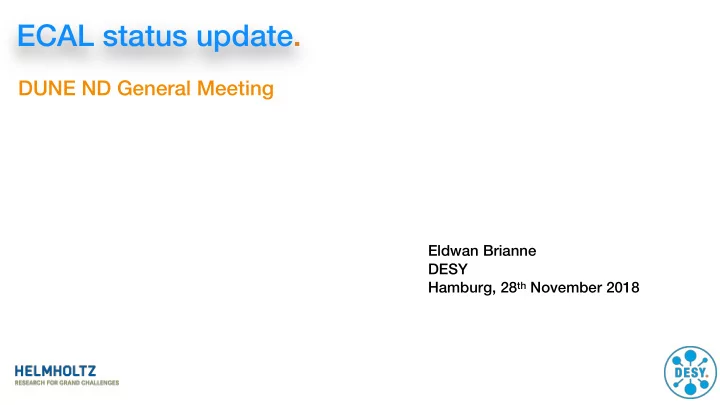

ECAL status update. DUNE ND General Meeting Eldwan Brianne DESY Hamburg, 28 th November 2018
New Geometry Design. Adapted to HPgTPC design • Requirements: • Contains the HPgTPC fiducial volume • R = 2.7 m, L = 5.5 m • Fits planar geometry of a high granular sampling calorimeter and matches cylindrical design of the TPC and PV → octagonal shape • Rough dimensions • Side length ~ 2.25 m 𝛏 • Surface: ~ 100 m 2 (Barrel), ~ 50 m 2 (Endcap) • Magnetic field • Parallel to TPC axis (drift direction in x) • Perpendicular to beam direction � 2 Eldwan Brianne | ECAL Status update | 28/11/2018 Page
New Geometry Design. Taking into account the physics • Mostly physics is going forward ( ~ fixed target experiment ) • May not need same depth/granularity everywhere • However, requires some understanding and optimisation • First thought: • Downstream region with High resolution/granularity • Upstream region + Endcaps with Low resolution/granularity • Variable longitudinal segmentation: • Thin layers in front for good E res for low-E photons • Thicker layers in the back for containment while keeping compact detector � 3 Eldwan Brianne | ECAL Status update | 28/11/2018 Page
Readout considerations. Need balance between granularity and cost • High granularity readout planes • → Individual scintillator tiles, one SiPM/tile • Low granularity planes • Layers of crossed strips readout on both sides (strips have full length of segment ~ up to 2.5 m). Light guided with WLS • Modules can be optimised for the strip length � 4 Eldwan Brianne | ECAL Status update | 28/11/2018 Page
Calorimeter structure. A mix between high and low granularity • Modules consist of a mix with a HG region and LG granularity region • HG layers interleaved with LG layers, need some optimisation • Typical EM shower see ~ 4 HG layers • Transition region between HG/LG regions? • Number of HG layers can di ff er for the DS/US regions • Use of di ff erent absorber thicknesses to enhance the angular resolution / shower containment � 5 Eldwan Brianne | ECAL Status update | 28/11/2018 Page
A starting point. Considering world constraints • Taking previous studies into account: • Granularity is important in the first layers • Thinner absorber (in the first layers) is beneficial for low-energy photons + give better lever arm on the shower direction • Calorimeter depth relevant for higher energies (not to neglect) DS Segments (3) US Segments (7) HG Layers (1 cm of Sc) 8 6 HG Tile size 2.5 x 2.5 cm 2 2.5 x 2.5 cm 2 HG Absorber thickness (Cu) 2 mm 2 mm Number of front layers 20 20 LG Layers 47 39 LG strip width (1 cm of Sc, crossed) 4 cm 4 cm LG Absorber thickness (Cu) 4 mm 4 mm Number of rear layers 35 25 Total thickness 15.6 X 0 12.8 X 0 Number of channels ~ 1.5 - 2 M (ignoring module widening, overlaps…) � 6 Eldwan Brianne | ECAL Status update | 28/11/2018 Page
First steps. Creating the new geometry • Changed to new software (DD4hep) to simplify the optimisation (https://github.com/ebrianne/DUNE_DD4hep_Geo) • Global/local variables used to define the geometry • Can be changed easily at run-time • Several options for the optimisation • Conversion to gdml then use GArSoft to run the analysis/ reconstruction; main trouble will be in the segmentation… • Run directly simulation with DD4hep (direct conversion from TGeo -> G4 geometry) and write plugin to get the same output as GArSoft; advantage segmentation plugins are already provided; however would need plugin to use GENIE as input for the simulation • New geometry is almost finished • Design will be optimised based on results (hopefully soon) � 7 Eldwan Brianne | ECAL Status update | 28/11/2018 Page
Next steps. Understanding performance and limitations • Detector geometry is almost implemented • Implement segmentation in GArSoft for reconstruction… (studies can be started at the simulation level) • Understand photon/neutron distribution of neutrino events, is the detector geometry sensible? • Understand detector performance: • Need reconstruction for tiles and strips (can be rudimentary, maybe not straight forward) • Performance scaling with parameter variation: • Absorber thickness, scintillator thickness • Cell size, strips width • Arrangement of HG/LG layers: optimal placement of HG layers? Benefits? • What are the limitations of such design? In term of energy resolution, angular resolution, non-uniformity response and material in HG layers… � 8 Eldwan Brianne | ECAL Status update | 28/11/2018 Page
Recommend
More recommend